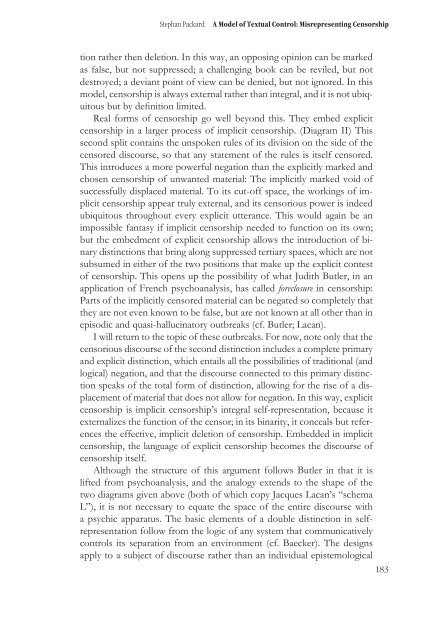Literatura in cenzura - Društvo za primerjalno književnost - ZRC SAZU
Literatura in cenzura - Društvo za primerjalno književnost - ZRC SAZU
Literatura in cenzura - Društvo za primerjalno književnost - ZRC SAZU
- No tags were found...
Create successful ePaper yourself
Turn your PDF publications into a flip-book with our unique Google optimized e-Paper software.
Stephan Packard:A Model of Textual Control: Misrepresent<strong>in</strong>g Censorshiption rather then deletion. In this way, an oppos<strong>in</strong>g op<strong>in</strong>ion can be markedas false, but not suppressed; a challeng<strong>in</strong>g book can be reviled, but notdestroyed; a deviant po<strong>in</strong>t of view can be denied, but not ignored. In thismodel, censorship is always external rather than <strong>in</strong>tegral, and it is not ubiquitousbut by def<strong>in</strong>ition limited.Real forms of censorship go well beyond this. They embed explicitcensorship <strong>in</strong> a larger process of implicit censorship. (Diagram II) Thissecond split conta<strong>in</strong>s the unspoken rules of its division on the side of thecensored discourse, so that any statement of the rules is itself censored.This <strong>in</strong>troduces a more powerful negation than the explicitly marked andchosen censorship of unwanted material: The implicitly marked void ofsuccessfully displaced material. To its cut-off space, the work<strong>in</strong>gs of implicitcensorship appear truly external, and its censorious power is <strong>in</strong>deedubiquitous throughout every explicit utterance. This would aga<strong>in</strong> be animpossible fantasy if implicit censorship needed to function on its own;but the embedment of explicit censorship allows the <strong>in</strong>troduction of b<strong>in</strong>arydist<strong>in</strong>ctions that br<strong>in</strong>g along suppressed tertiary spaces, which are notsubsumed <strong>in</strong> either of the two positions that make up the explicit contestof censorship. This opens up the possibility of what Judith Butler, <strong>in</strong> anapplication of French psychoanalysis, has called foreclosure <strong>in</strong> censorship:Parts of the implicitly censored material can be negated so completely thatthey are not even known to be false, but are not known at all other than <strong>in</strong>episodic and quasi-halluc<strong>in</strong>atory outbreaks (cf. Butler; Lacan).I will return to the topic of these outbreaks. For now, note only that thecensorious discourse of the second dist<strong>in</strong>ction <strong>in</strong>cludes a complete primaryand explicit dist<strong>in</strong>ction, which entails all the possibilities of traditional (andlogical) negation, and that the discourse connected to this primary dist<strong>in</strong>ctionspeaks of the total form of dist<strong>in</strong>ction, allow<strong>in</strong>g for the rise of a displacementof material that does not allow for negation. In this way, explicitcensorship is implicit censorship’s <strong>in</strong>tegral self-representation, because itexternalizes the function of the censor; <strong>in</strong> its b<strong>in</strong>arity, it conceals but referencesthe effective, implicit deletion of censorship. Embedded <strong>in</strong> implicitcensorship, the language of explicit censorship becomes the discourse ofcensorship itself.Although the structure of this argument follows Butler <strong>in</strong> that it islifted from psychoanalysis, and the analogy extends to the shape of thetwo diagrams given above (both of which copy Jacques Lacan’s “schemaL”), it is not necessary to equate the space of the entire discourse witha psychic apparatus. The basic elements of a double dist<strong>in</strong>ction <strong>in</strong> selfrepresentationfollow from the logic of any system that communicativelycontrols its separation from an environment (cf. Baecker). The designsapply to a subject of discourse rather than an <strong>in</strong>dividual epistemological183
















